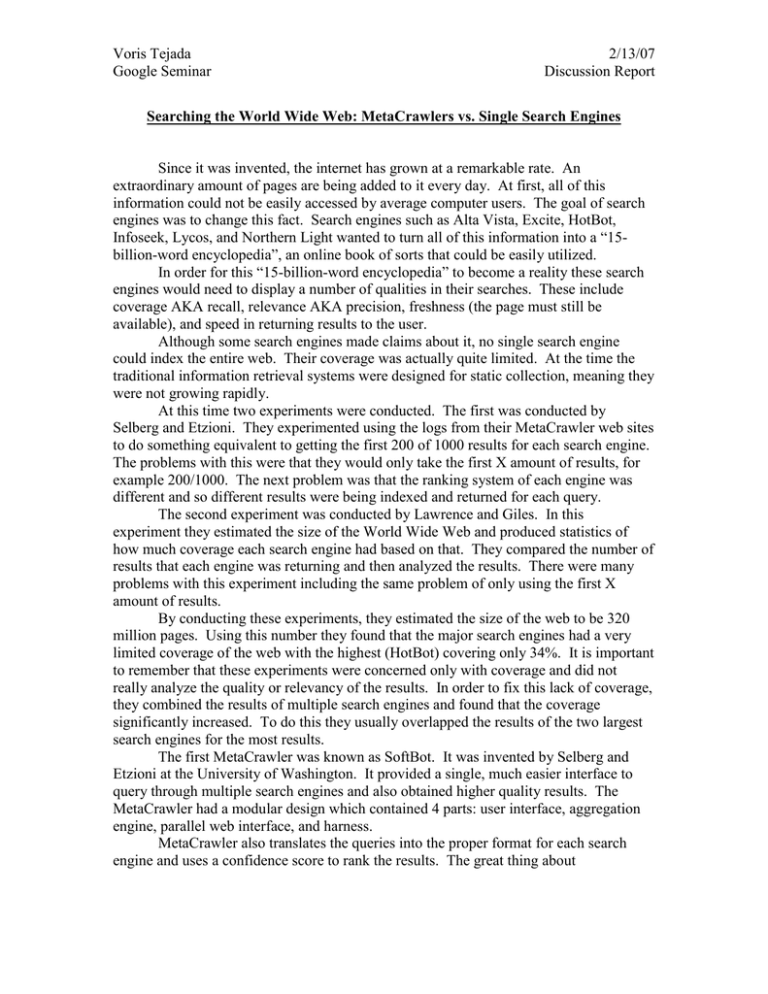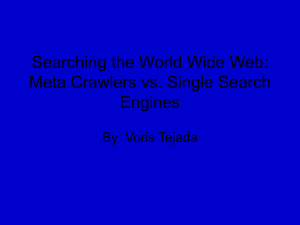Voris Tejada 2/13/07 Google Seminar
advertisement

Voris Tejada Google Seminar 2/13/07 Discussion Report Searching the World Wide Web: MetaCrawlers vs. Single Search Engines Since it was invented, the internet has grown at a remarkable rate. An extraordinary amount of pages are being added to it every day. At first, all of this information could not be easily accessed by average computer users. The goal of search engines was to change this fact. Search engines such as Alta Vista, Excite, HotBot, Infoseek, Lycos, and Northern Light wanted to turn all of this information into a “15billion-word encyclopedia”, an online book of sorts that could be easily utilized. In order for this “15-billion-word encyclopedia” to become a reality these search engines would need to display a number of qualities in their searches. These include coverage AKA recall, relevance AKA precision, freshness (the page must still be available), and speed in returning results to the user. Although some search engines made claims about it, no single search engine could index the entire web. Their coverage was actually quite limited. At the time the traditional information retrieval systems were designed for static collection, meaning they were not growing rapidly. At this time two experiments were conducted. The first was conducted by Selberg and Etzioni. They experimented using the logs from their MetaCrawler web sites to do something equivalent to getting the first 200 of 1000 results for each search engine. The problems with this were that they would only take the first X amount of results, for example 200/1000. The next problem was that the ranking system of each engine was different and so different results were being indexed and returned for each query. The second experiment was conducted by Lawrence and Giles. In this experiment they estimated the size of the World Wide Web and produced statistics of how much coverage each search engine had based on that. They compared the number of results that each engine was returning and then analyzed the results. There were many problems with this experiment including the same problem of only using the first X amount of results. By conducting these experiments, they estimated the size of the web to be 320 million pages. Using this number they found that the major search engines had a very limited coverage of the web with the highest (HotBot) covering only 34%. It is important to remember that these experiments were concerned only with coverage and did not really analyze the quality or relevancy of the results. In order to fix this lack of coverage, they combined the results of multiple search engines and found that the coverage significantly increased. To do this they usually overlapped the results of the two largest search engines for the most results. The first MetaCrawler was known as SoftBot. It was invented by Selberg and Etzioni at the University of Washington. It provided a single, much easier interface to query through multiple search engines and also obtained higher quality results. The MetaCrawler had a modular design which contained 4 parts: user interface, aggregation engine, parallel web interface, and harness. MetaCrawler also translates the queries into the proper format for each search engine and uses a confidence score to rank the results. The great thing about Voris Tejada Google Seminar 2/13/07 Discussion Report MetaCrawler was that it did this fast and gave you partial results while the later results were still downloading. The four most commonly known MetaCrawlers today are Dogpile, Metacrawler, Excite, and Webcrawler.





